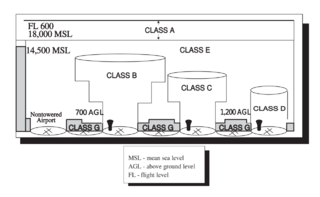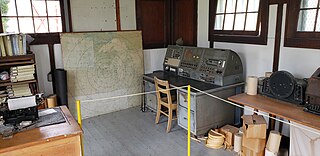Related Research Articles

The Federal Aviation Administration (FAA) is the largest transportation agency of the U.S. government and regulates all aspects of civil aviation in the country as well as over surrounding international waters. Its powers include air traffic control, certification of personnel and aircraft, setting standards for airports, and protection of U.S. assets during the launch or re-entry of commercial space vehicles. Powers over neighboring international waters were delegated to the FAA by authority of the International Civil Aviation Organization.

Air traffic control (ATC) is a service provided by ground-based air traffic controllers who direct aircraft on the ground and through a given section of controlled airspace, and can provide advisory services to aircraft in non-controlled airspace. The primary purpose of ATC worldwide is to prevent collisions, organize and expedite the flow of air traffic, and provide information and other support for pilots.

Airspace is the portion of the atmosphere controlled by a country above its territory, including its territorial waters or, more generally, any specific three-dimensional portion of the atmosphere. It is not the same as aerospace, which is the general term for Earth's atmosphere and the outer space in its vicinity.
In United States and Canadian aviation, the Aeronautical Information Manual (AIM) is the respective nation's official guide to basic flight information and air traffic control procedures.

A flight service station (FSS) is an air traffic facility that provides information and services to aircraft pilots before, during, and after flights, but unlike air traffic control (ATC), is not responsible for giving instructions or clearances or providing separation. They do, however, relay clearances from ATC for departure or approaches. The people who communicate with pilots from an FSS are referred to as flight service specialists.
A UNICOM station is an air-ground communication facility operated by a non-air traffic control private agency to provide advisory service at uncontrolled aerodromes and airports and to provide various non-flight services, such as requesting a taxi, even at towered airports. It is also known as an aeronautical advisory station. The equivalent European/ICAO service is known as (aerodrome) flight information service, abbreviated as AFIS or FIS.
An aerodrome beacon or rotating beacon or aeronautical beacon is a beacon installed at an airport or aerodrome to indicate its location to aircraft pilots at night.

The National Air Traffic Controllers Association (NATCA) is a labor union in the United States. It is affiliated with the AFL–CIO, and is the exclusive bargaining representative for air traffic controllers employed by the Federal Aviation Administration (FAA). It also represents a range of workers related to the air traffic control (ATC) industry, and the FAA itself.
In aviation, a standard terminal arrival (STAR) is a published flight procedure followed by aircraft on an instrument flight rules (IFR) flight plan just before reaching a destination airport.

In aviation, a non-towered airport is an airport without a control tower, or air traffic control (ATC) unit. The vast majority of the world's airports are non-towered. In the United States, there are close to 20,000 non-towered airports compared to approximately 500 airports with control towers. Airports with a control tower without 24/7 ATC service follow non-towered airport procedures when the tower is closed but the airport remains open, for example at night.
ATC Zero is an official term used by the U.S. Federal Aviation Administration (FAA) that means the FAA is unable to safely provide the published ATC services within the airspace managed by a specific facility. The term is always used in conjunction with a facility reference. FAA ATC facilities include Air Route Traffic Control Centers (ARTCC); Terminal Radar Control facility (TRACON), Air Traffic Control Tower (ATCT), Flight Service Stations (FSS), or the Air Traffic Control System Command Center (ATCSCC). The term is defined in FAA Order JO 1900.47, Air Traffic Control Operational Contingency Plans. It is one of three designations used by the FAA to describe degraded operations and invoke operational contingency plans.
Wake turbulence categories and wake turbulence groups are defined by the International Civil Aviation Organization for the purpose of separating aircraft in flight, due to wake turbulence.

The Air Traffic Organization (ATO) is an air navigation service provider in the United States of America. The ATO is the operational division of the Federal Aviation Administration (FAA).
In United States aviation, MARSA designates the delegation of responsibility for separation of aircraft in flight to military authorities by civilian air traffic control authorities. MARSA is an acronym for Military Authority Assumes Responsibility for Separation of Aircraft.
Mike Monroney Aeronautical Center is a regional office of the United States Federal Aviation Administration on the grounds of Will Rogers Airport in Oklahoma City. With around 7,500 direct federal employees, the Aeronautical Center is one of the Department of Transportation's largest facilities outside the Washington, DC area, and one of the 10 largest employers in the Oklahoma City metropolitan area. It is named for Senator Mike Monroney of Oklahoma, who wrote and sponsored the Federal Aviation Act of 1958.

Kansas City Air Route Traffic Control Center, is one of 22 Federal Aviation Administration (FAA) Area Control Centers. It is located at 250 S. Rogers Rd. Olathe, Kansas, United States.
Aeronautical phraseology is a set of communication rules for simplified English language communication between an air traffic controller and the pilot in command of an aircraft. In the majority of countries, the aeronautical phraseology in use is based on standards developed by the International Civil Aviation Organization.
References
- ↑ List of current versions of Air Traffic Orders on the FAA website
- ↑ "JO 7110.65Z - Air Traffic Control – Document Information". www.faa.gov. Retrieved 2021-09-10.
- ↑ Van West, Jeff; Lane-Cummings, Kevin (2007). Microsoft Flight Simulator X For Pilots: Real World Training. Wiley Publishing. p. 700. ISBN 978-0-764-58822-8 . Retrieved 2014-03-25.